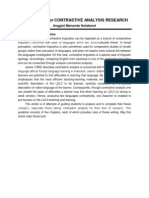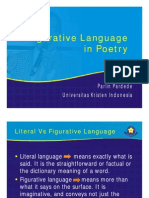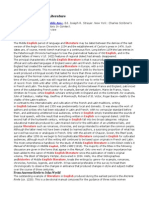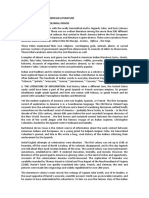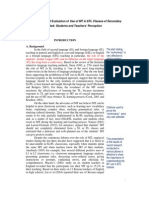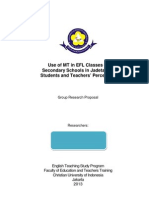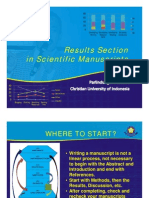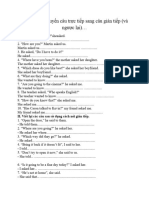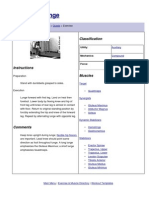Middle English
Middle English
Uploaded by
Parlindungan PardedeCopyright:
Available Formats
Middle English
Middle English
Uploaded by
Parlindungan PardedeOriginal Title
Copyright
Available Formats
Share this document
Did you find this document useful?
Is this content inappropriate?
Copyright:
Available Formats
Middle English
Middle English
Uploaded by
Parlindungan PardedeCopyright:
Available Formats
Chapter 3: Middle English
MIDDLE ENGLISH PERIOD (10661485)
his period is the name given to the transition period during which Old English was changing to Modern English. This period lasted from the middle of the 11 th century (1066) to the middle of the 16th century. The year 1066 is taken because in this year one of the most important events in English history took place, namely The Norman Conquest. This event is important not only because it completely changed the course of English literature but also significantly influenced the development of English language. The Norman Conquest was the last successful invasion of Britain. It was led by William, Duke of Normandy, later known as William the Conqueror. After defeating King Harold at the Battle of Hastings in 1066, the Normans took power and William became King of England. He tried to bring peace to the country after many centuries of wars and invasions but did not always succeed. The arrival of the Norman introduced England to French (a language derived from Latin), better architecture, progress in painting and music. Not long after the conquest, the University of Cambridge and Oxford were established. Another impact of the conquest is the parallel use of both English and French. Soon after the conquest, French became the language used by educated people, i.e. in offices, royal courts, and also by poets. The Anglo-Saxon (Old English) was spoken only by uneducated people. This situation of two parallel languages in daily use in the same country lasted for more than 300 years. In the field of literature, we could say that the first hundred and fifty years of this period had little intrinsic worth, but it was historically important for the sake of the
William the Conqueror defeated King Harold at the Battle of Hastings, 1066
An Outline of English Literature (For EESP of UKI Use only)
10
Chapter 3: Middle English
evolution of modern English literature. There may be several reasons to the blank time of production of literary works. Firstly, the conquest has stunned English literature into silence. Secondly, the limitation of Anglo-Saxon language probably prevented it from further advance. Thirdly, the Norman, at the conquest, had no literature to offer, because at that time French literature was still at its infancy which later on become dominant in Europe during the 12th and 13th century. By taking the French literature as its model, English literature revived at the beginning of the 13th century. This process of assimilation, however, enriched English literature because the French, different from the Anglo-Saxon, which was humorous less in spirit, hard in vocabulary, and monotonous in alliteration (although it had more feeling and thought), was gay and colorful in spirit, soft in vocabulary and musical in its bright verse. The first valuable work produced on the French influence is Layamons Brut (1205). This voluminous poem, contains 30,000 lines, is a legendary history of Britain, named after Brut or Brutus, the grandson of Aeneas, one of the heroes of Troy. Brutus is supposed to be the founder of Britain and of new Troy of London. Layamon brings his account down to Cadwallader, the last of the Celtic kings. This verse is a translation from French, but what makes it interesting is that it introduces, for the first time, the story of King Arthur. The most interesting of all works produced in the first quarter of the 13 th century is The Owl and the Nightingale, a verse debate between two birds mentioned in the title about life: to live morally or to live for pleasures. The two birds argue topics ranging from their hygienic habits, looks, and songs to marriage, prognostication, and the proper modes of worship. The nightingale stands for the joyous aspects of life, the owl for the somber; there is no clear winner, but the debate ends as the birds go off to state their cases to one Nicholas of Guildford, a wise man. The poem is learned in the clerical tradition but wears its learning lightly as the disputants speak in colloquial and sometimes earthy language. The Owl and the Nightingale is metrically regular (octosyllabic couplets) and uses the French metre with an assurance that is astonishing in so early a poem. In addition, it also important to note that it was during this era when English ballads, e.g. Robin Hood, began to appear. These ballads are initially in oral form, and they generally reflect daily life of lower class people in England at that time. Chaucer The use of two parallel languages in England ended in the 14th century, because the Middle English had been accepted as the only language used in all levels. This situation developed English literature of the middle period to reach its highest peak. The greatest literary figure of this time is Geoffrey Chaucer. He was influenced by many kinds of writing and used many European models. For example, his first poems were dream poems, using the Old English model: Troylus and Creyside (about I385) uses a story from classical Greek times; and The House of Fame (I370s) uses the Latin poet Ovid and the Italian poet Dante (I265--I32I) as its
An Outline of English Literature (For EESP of UKI Use only)
Geoffrey Chaucer, oil on panel by an unknown artist. 11
Chapter 3: Middle English
influences. Chaucer was a European in outlook and experi ence, but his ambition was to make the literature of English the equal of any other European writing. Chaucers greatest work is The Canterbury Tales [tales = stories] (I387-I400). It is also the first major work in English literature. It is a series (never completed) of linked stories. In it a group of about 30 pilgrims gather at the Tabard Inn in Southwark, across the Thames from London, and agree to engage in a storytelling contest as they travel on horseback to the shrine of Thomas Becket in Canterbury, Kent, and back. There are many aspects to The Canterbury Tales, both secular and religious. The time is spring (April) when the world comes to life again after the long winter; and the people are from every level of society, except the highest and the lowest a wide range of the new middle class, including a knight [a soldier], a scholar of Oxford, a nun, the wife of Bath, a simple-minded peasant, and several religious figures and tradesmen. And the stories which they tell are also very different some are classical, some modern, some moral, some the opposite. Chaucer took the idea of linked series of stories from the Italian writings of Boraccio, but he sets them clearly in the here and now of late fourteenth century England. He had planned for 120 stories, but only 24 of them were written. However, The Canterbury Tales is still the great mirror of its times, and a great collection of comic views of the life it describes. For example, the knight is seen as a figure from a past age who does not fit in very well with the new modern society. Chaucer uses irony to describe him as a verray parfit gentil knight [parfit = perfect, gentil = gentle)completely ferfect and gentle are high moral values which are difficult to keep. In his story, self -interest is one of the main themes: And therefore, at the kynges court, my brother, Each man for hymself, ther is noon oother. And therefore, at the king's court, my brother, Each man for himself, there is no other way. (The Knights Tale) Chaucer is describing a society that is changing, and its people and their values are changing, too. Again and again the stories and the story-tellers contrast old ways of behaving and of thinking with more modern attitudes. So religion is less important than enjoying life, and making money is a new ambition: But al be that he was a philosophre, Yet hadde he but litel gold in cofre; But although he was a philosopher, Nevertheless he had only a little gold in his coffer 1. (General Prologue 2 )
1
box for storing things
introduction
Some of the ideas in The Canterbury Tales sound very modern, and show that Chaucer was interested in wider themes:
An Outline of English Literature (For EESP of UKI Use only)
12
Chapter 3: Middle English
What is this world? what asketh men to have? Now with his love, now in his colde grave Allone, withouten any compaignye. What is this world? what do men ask for? Now with his love, now in his cold grave Alone, without any companionship. (The Knights Tale) Another famous poet of this time is William Langland who wrote, among others,
Piers Plowman which uses the dream-vision form to write a long series of dream
stories. It is a social allegory which stress the importance of hard-workings and honesty in life. Many anonymous texts appeared in this era. The most popular are Pearl and Sir Gawain and the Green Night. Both of them also explore the themes of emotions and human weakness. The first is a dream a father has of his daughter who died. She is now perfect, in heaven, and the father can see how far she is from the human level. Sir Gawain is one of the Knights of the Round Table, from the court of King Arthur, and is expected to be brave, honest and honourable. One evening a huge green man enters the court and challenges a knight to cut his head off. But the knight must have his own head cut off one year later. Gawain accepts the challenge and cuts off the head of the green man. A year later Sir Gawain is looking for the Green Knight when he arrives at a castle. The lord of the castle has a beautiful wife who tempts Gawain. She gives him a magic belt which will save his life. When Gawain finally meets the Green Knight he uses the belt. He deceives the knight and so he does not accept the challenge with true bravery. The Green Knight is really the lord of the castle and when Sir Gawain accepts that he is not an ideal brave hero he is forgiven by the Green Knight. Gawain returns to the court of King Arthur and is praised for his braver y. Gawain is, in fact, a kind of anti-hero, and the poem is an ironic questioning of the value of the historical myth of heroism in those changed times, much as Chaucer questioned the old -fashioned values of his knight. Prose Due to the part that poetry was considered as a high class art, lower-class people of the middle age tried to take prose as their art. The most well -known figure in prose-writing in this era is John Wyclif (13241384). He was a scholar and a priest who was popular as a translator of the Bible. His prose-style put in the scripture was adopted by many people and gave a great influence to the development of english to its standard form. Another famous work of Wyclif is Mendelvilles Travel , the authors reportage about his travels to various countries. Another great prose-writer of this era is John Gower. He wrote a great many books, in Latin and in French as well as in English. His most famous is Confessio
An Outline of English Literature (For EESP of UKI Use only)
13
Chapter 3: Middle English
Amantis , the confession of a lover. At the end the lover says he will give up love but only because he is getting too old. Just like in The Canterbury Tales and Piers Plowman , there is irony in Gowers works, and the subject matter is clearly very far
from the heroism of Old English: emotions and human weakness are becoming more common themes in literature.
Drama The main writing of this period was in poetry, but the tradition of drama, in addition to prose, was beginning at this time, too. The original medieval dramas were set in and around the church at festival times, and they showed scenes from the Bible for an audience who perhaps could not understand the latin of the Bible. The play s were called mystery or miracle plays because they showed the mysterious or miraculous events of the Bible and the saints lives. The plays were usually performed on moving carts, by the businessmen of the city, and the texts which remains are often called by the name of the group of businessmen which first performed them. ( e.g. the Fishers and Mariners). Groups of these plays remain from the cities of York, Wakefield, and Chester in particular, and all have local differences in the stories they tell and the way they are told. Many of the theatrical effects were very impressiveHells Mouth is the most famous example. These plays are an important step towards the great theatrical period at the end of the sixteenth century. Influenced by the work of Chaucer in England, a group of writers in Scotlans produced some major poetry. They came to be known as the Scottish Chaucerian, although the language they used was Scots rather than English. The names of these writers, the first great figures in Scottish literature, areRobert Henryson and William Dunbar. It is interesting that the King of Scotland, King James the First (1394 1437) was also an important poet. His Kingis Quair [King's Book] (c. I425) is a book of love poetry written in the verse form which, because of his use of it, came to be known as rhyme-royal. The major event in literary terms in the fifteenth century was the invention of printing, by Gutenberg (1398-1468) in Germanv. The first books to be printed were Bibles, but when William Caxton and later his assistant, Wynken de Worde, brought printing to England in the 1470s, they began to print literary works, the first of which was a story of King Arthur and the Knights of the Round Table, called Le Morte d Arthur by Sir Thomas Malory, published in 1485. The author had died several years before Caxton published the bookand it is nat even certain who Malory was. The book, centering on the legendary king Arthur (q.v.), is based on a Middle English alliterative poem in dialect from the century before, but Malory's t elling of the story is the one which has remained popular ever since. The book covers Arthur's birth, the adventures of his knights, and the adulterous love between his knight Sir Lancelot and his queen, Guinevere. This last situation and the quest for the Holy Grail (the vessel used by Christ at the Last Supper and given to Joseph of Arimathea) brought about the dissolution of the knightly fellowship, the death of Arthur, and the destruction of his kingdom. Since the story had already been familiar before it was published, its a part of the English national consciousness. It is almost the national myth, and has remained popular until the present day.
An Outline of English Literature (For EESP of UKI Use only)
14
Chapter 3: Middle English
An illustration for Le Morte dArthur, by Sir Thomas Malory
The final figure in the late medieval period is John ,Skelton, a very individual poet who wrote short rapid lines of poetry about such subjects as drinking alcohol, a. pet bird, and low life. Here his pet bird, a sparrow, complains about cats: Vengeance1 I ask and cry By way nf exclamation On the whole nation Of cats wild and tame: God send them sorrow and shame! (`Phyllyp Sparrow')
1
revenge
Skelton's humour, as well as his poetic style, are unique. He and his poetry are difficult to describe, and not many critics have written about him in literary history. But he brings together many of the themes of the middle English period: humour, and a different view on the values of the time, new verse forms and play with language and style, and a strong sense of English identity.
An Outline of English Literature (For EESP of UKI Use only)
15
You might also like
- Lesson Plans of TRANSLATION 1Document6 pagesLesson Plans of TRANSLATION 1Izha Nor HasanahNo ratings yet
- Changes in English Language During The RenaissanceDocument26 pagesChanges in English Language During The RenaissanceLoire Aviles Collamat50% (2)
- Stop and Check 9-12Document3 pagesStop and Check 9-12Polett100% (1)
- Chapter 14 - DisadvantageDocument16 pagesChapter 14 - DisadvantageYesicha Ryona50% (2)
- The Nature of Reading PDFDocument13 pagesThe Nature of Reading PDFParlindungan Pardede100% (13)
- Sentence Comprehension PDFDocument8 pagesSentence Comprehension PDFParlindungan PardedeNo ratings yet
- A Guideline For Contrastive Analysis ResearchDocument5 pagesA Guideline For Contrastive Analysis ResearchParlindungan Pardede100% (1)
- Figurative Language in PoetryDocument19 pagesFigurative Language in PoetryParlindungan Pardede100% (1)
- Massive MIMODocument68 pagesMassive MIMOraj1978enatorNo ratings yet
- Medieval (ENGLISH)Document2 pagesMedieval (ENGLISH)Cindy OctavinaNo ratings yet
- Middle English LiteratureDocument15 pagesMiddle English LiteratureGustavo KofmanNo ratings yet
- A. Larson (1984) B. Newmark (1988) C D. Catford (1978) : - Nida (1965)Document11 pagesA. Larson (1984) B. Newmark (1988) C D. Catford (1978) : - Nida (1965)ipank HJTcropTopNo ratings yet
- Discourse Analysis and Grammar.Document15 pagesDiscourse Analysis and Grammar.Nini HarlianiNo ratings yet
- Poem AnalysisDocument9 pagesPoem AnalysisEarven Cardoniga ValdesimoNo ratings yet
- Esp Approach Not ProductDocument9 pagesEsp Approach Not Producteka fitria yuliyantiNo ratings yet
- Speech CommunitiesDocument2 pagesSpeech CommunitiesDekaNo ratings yet
- Psycholiguistics and Linguistic Aspects of InterlanguageDocument10 pagesPsycholiguistics and Linguistic Aspects of InterlanguageJuragan FilmNo ratings yet
- Early American and Colonial Period in LiteratureDocument38 pagesEarly American and Colonial Period in LiteratureLovely Regine07100% (1)
- The Role of ESP TeacherDocument11 pagesThe Role of ESP TeacherElías Ruiz CadenaNo ratings yet
- Materials Design and Lesson Planning - PoetryDocument3 pagesMaterials Design and Lesson Planning - PoetryJonathan AcuñaNo ratings yet
- Internal and External Factor of SlaDocument8 pagesInternal and External Factor of SlaInayah Yosi NoordiniNo ratings yet
- Language Testing: Approaches and TechniqueDocument18 pagesLanguage Testing: Approaches and TechniqueAkira Akira100% (1)
- Item Types and Tasks For Assessing SpeakingDocument14 pagesItem Types and Tasks For Assessing SpeakingnazlaNo ratings yet
- Attitudes and ApplicationsDocument10 pagesAttitudes and ApplicationsArin Azkiya100% (2)
- Discussion Text Teaching English in Elementary SchoolDocument2 pagesDiscussion Text Teaching English in Elementary SchoolEkoNo ratings yet
- Poetry AnalysisDocument14 pagesPoetry AnalysisJody SetyawanNo ratings yet
- ESP An Approach Not A Product-1Document5 pagesESP An Approach Not A Product-1Diah100% (1)
- Testing, Assessing, and Teaching Chapter 1Document11 pagesTesting, Assessing, and Teaching Chapter 1Yamith J. Fandiño91% (11)
- Advanced LinguisticsDocument8 pagesAdvanced LinguisticsMega Perbawati50% (2)
- Cause and Effect PengayaanDocument5 pagesCause and Effect PengayaanLutvia AnggitaNo ratings yet
- PPT MorphemeDocument18 pagesPPT MorphemeKinerja Dosen PBINo ratings yet
- E4introducing Lang and Lit MCQ 200 QuestionsDocument34 pagesE4introducing Lang and Lit MCQ 200 QuestionsZahidaWaseemNo ratings yet
- Recognizing Phonological and Morphological Elements A. Phonemic Pair, VowelsDocument24 pagesRecognizing Phonological and Morphological Elements A. Phonemic Pair, VowelsUkma DayanaNo ratings yet
- Dita Topic 9 SyntaxDocument3 pagesDita Topic 9 SyntaxHendra UwaisNo ratings yet
- Introduction - Describing and Explaining L2 AcquisitionDocument2 pagesIntroduction - Describing and Explaining L2 AcquisitionKha WlaNo ratings yet
- Choosing A Coursebook 1Document22 pagesChoosing A Coursebook 1Latifa RahayuNo ratings yet
- Pragmatics Reference and InferenceDocument10 pagesPragmatics Reference and InferenceMiftahul Jannah100% (1)
- Anglo-Norman Period (1066-1350)Document27 pagesAnglo-Norman Period (1066-1350)Mathews Sajit50% (2)
- Colonial Period of American LiteratureDocument5 pagesColonial Period of American LiteratureHeidy Teresa MoralesNo ratings yet
- Headless, Blends and AcronymsDocument4 pagesHeadless, Blends and AcronymsAbdullatif AssalamNo ratings yet
- Theoretical Framework of SLADocument19 pagesTheoretical Framework of SLADaisy Alegre MarcosNo ratings yet
- ESPDocument7 pagesESPEka Putri INo ratings yet
- Lecture 1-Types of Islamic Texts and Their Characteristics-Translation of Proper NamesDocument11 pagesLecture 1-Types of Islamic Texts and Their Characteristics-Translation of Proper Namesyoshi hiNo ratings yet
- Theme and Rheme: From The Functional GrammarDocument10 pagesTheme and Rheme: From The Functional GrammarHana NurshafaNo ratings yet
- Commonwealth and Restoration - LiteratureDocument15 pagesCommonwealth and Restoration - Literatureaninditarina100% (1)
- MorphemeDocument4 pagesMorphemeSaurav SenguptaNo ratings yet
- What Are The Different Ways We Say ThingsDocument2 pagesWhat Are The Different Ways We Say Thingsvitaloka siwi utamiNo ratings yet
- Assess. of Lit. Abal 1st Sem.Document33 pagesAssess. of Lit. Abal 1st Sem.Jessamie EntrinaNo ratings yet
- Syllabus DesignDocument18 pagesSyllabus DesignAnonymous Wj6Bhcbw100% (1)
- Characterizing The Essentials of Methods: Language Focus: Speech Communication vs. LiteratureDocument7 pagesCharacterizing The Essentials of Methods: Language Focus: Speech Communication vs. LiteraturePourya Hell100% (1)
- Poetry: Definition of Poetry According To ExpertsDocument5 pagesPoetry: Definition of Poetry According To ExpertsSastrawan PelawiNo ratings yet
- The Development of Speech ProductionDocument24 pagesThe Development of Speech ProductionNadia TurRahmi100% (1)
- The Contemporary Period (1939 - Present)Document7 pagesThe Contemporary Period (1939 - Present)dulce crissNo ratings yet
- Testing WritingDocument10 pagesTesting WritingMarhamatul KhairiyahNo ratings yet
- Makalah Pidgin and CreolesDocument10 pagesMakalah Pidgin and Creolesalyssa ayuningtyas100% (1)
- Old English (Anglo-Saxon) Period (450-1066)Document6 pagesOld English (Anglo-Saxon) Period (450-1066)I Putu ArtawanNo ratings yet
- Sense Properties and StereotypesDocument3 pagesSense Properties and StereotypesKholidyan Nugrahadi PutraNo ratings yet
- Overview of Literary Periods and MovementsDocument92 pagesOverview of Literary Periods and MovementsZarah Joyce SegoviaNo ratings yet
- Cooperative Language LearningDocument16 pagesCooperative Language LearningPatricia E Martin100% (4)
- The Literary GazeDocument316 pagesThe Literary GazeElenaNo ratings yet
- Commonwealth and Restoration PeriodDocument12 pagesCommonwealth and Restoration PeriodZiyaul Haq0% (1)
- Syntactic Linkage: by Haryono Lekat BaktiDocument7 pagesSyntactic Linkage: by Haryono Lekat Baktiamelia100% (1)
- Chapter 4: The Audio-Lingual Method: Textbook: Larsen-Freeman, D. (2000) - Techniques and Principles inDocument17 pagesChapter 4: The Audio-Lingual Method: Textbook: Larsen-Freeman, D. (2000) - Techniques and Principles insarim maulanaNo ratings yet
- Discourse Theme and RhemeDocument3 pagesDiscourse Theme and Rhememajaculj0% (1)
- Literature 3 Parlin Pardede - MiddleDocument9 pagesLiterature 3 Parlin Pardede - MiddleNeny Riani SianturiNo ratings yet
- English Literature: Vass JuditDocument50 pagesEnglish Literature: Vass JuditGödri Miklós Szabolcs ZsuzsannaNo ratings yet
- A Review On Reading Theories and Its Implication To TheDocument10 pagesA Review On Reading Theories and Its Implication To TheMarcio NoeNo ratings yet
- Online Reading StrategiesDocument11 pagesOnline Reading StrategiesParlindungan PardedeNo ratings yet
- An Overview of The Study of Language in The History of Philosophy (Renaissance To Postmodern)Document16 pagesAn Overview of The Study of Language in The History of Philosophy (Renaissance To Postmodern)Parlindungan PardedeNo ratings yet
- Seminar Schedule 2013/14 (Group B)Document2 pagesSeminar Schedule 2013/14 (Group B)Parlindungan PardedeNo ratings yet
- Introduction To Prose (Fiction)Document11 pagesIntroduction To Prose (Fiction)Parlindungan PardedeNo ratings yet
- Fact or OpinionDocument10 pagesFact or OpinionParlindungan PardedeNo ratings yet
- Introduction To ELT ResearchDocument16 pagesIntroduction To ELT ResearchParlindungan PardedeNo ratings yet
- Introduction To Critical ReadingDocument10 pagesIntroduction To Critical ReadingParlin PardedeNo ratings yet
- Proposal Evaluation - MT in EFL ClassDocument14 pagesProposal Evaluation - MT in EFL ClassParlindungan PardedeNo ratings yet
- Introduction To CCUDocument20 pagesIntroduction To CCUParlindungan PardedeNo ratings yet
- Quantitative Research ProcessDocument12 pagesQuantitative Research ProcessParlindungan PardedeNo ratings yet
- Americans' Basic FeatureDocument13 pagesAmericans' Basic FeatureParlindungan PardedeNo ratings yet
- ELT Research Proposal Sample - MT in EFL ClassesDocument26 pagesELT Research Proposal Sample - MT in EFL ClassesParlindungan Pardede95% (37)
- Thesis Approval FormDocument1 pageThesis Approval FormParlindungan PardedeNo ratings yet
- Proposal Seminar Schedule-ETSP 2012-2013 (Group-A)Document3 pagesProposal Seminar Schedule-ETSP 2012-2013 (Group-A)Parlindungan PardedeNo ratings yet
- Augustan PeriodDocument13 pagesAugustan PeriodParlindungan Pardede100% (3)
- Outline of Case Study or Survey-Based SkripsiDocument11 pagesOutline of Case Study or Survey-Based SkripsiParlindungan PardedeNo ratings yet
- Results Section in Scientific Manuscripts: SA A U D SDDocument15 pagesResults Section in Scientific Manuscripts: SA A U D SDParlindungan PardedeNo ratings yet
- Methods & Materials SectionDocument6 pagesMethods & Materials SectionParlindungan PardedeNo ratings yet
- Augustan Classical) PeriodDocument13 pagesAugustan Classical) PeriodParlindungan Pardede100% (2)
- Perspectives2 Worbook U2Document12 pagesPerspectives2 Worbook U2Eric Gabriel De La Puente PeloquinNo ratings yet
- Warhammer Aos Chaos enDocument5 pagesWarhammer Aos Chaos enFrancisco Palomares CaparrósNo ratings yet
- Listening A2 - Test 2Document4 pagesListening A2 - Test 2Nguyễn ThúyNo ratings yet
- Đề áp dụng chuyển câu trực tiếp sang câu gián tiếpDocument9 pagesĐề áp dụng chuyển câu trực tiếp sang câu gián tiếpngobakietntdNo ratings yet
- Training 21st Century Flutists HandoutDocument3 pagesTraining 21st Century Flutists Handoutsallyflute10% (1)
- Sony Hcd-Ec55 Ec77 Gx99Document104 pagesSony Hcd-Ec55 Ec77 Gx99Rommel S. EscalanteNo ratings yet
- Need For Speed V Rally 2 - Manual - Win - ENDocument28 pagesNeed For Speed V Rally 2 - Manual - Win - ENFagner CruzNo ratings yet
- 139-140 Halloween SpecialDocument44 pages139-140 Halloween SpecialFred Seibert100% (1)
- Sports WritingDocument28 pagesSports WritingSherlyn Manzano UrbanNo ratings yet
- Microsoft Sway For Digital Storytelling: Starting From ScratchDocument16 pagesMicrosoft Sway For Digital Storytelling: Starting From ScratchWilly Villa SalsavilcaNo ratings yet
- WeddingsDocument2 pagesWeddingsDigital MediaNo ratings yet
- HSG 11 - Sentence TransformattionDocument6 pagesHSG 11 - Sentence Transformattionanhphuong26111No ratings yet
- Paul Osborne - Where Is She Magia IlusionDocument2 pagesPaul Osborne - Where Is She Magia IlusionXristos smerosNo ratings yet
- 217 BA - Marketing Analytics CCEDocument3 pages217 BA - Marketing Analytics CCESpNo ratings yet
- 10 Easy Steps To Create The "Classic" Princess Seams Bodice: Sign Up For The Isn'T That Sew EmailerDocument1 page10 Easy Steps To Create The "Classic" Princess Seams Bodice: Sign Up For The Isn'T That Sew EmailerAmanie Usman Amanoddin0% (1)
- prompt minimaxDocument6 pagesprompt minimaxmageprincehanunakiNo ratings yet
- City Garden Map and GuideDocument1 pageCity Garden Map and GuidenextSTL.comNo ratings yet
- GoTo To Announce First Quarter 2023 ResultsDocument2 pagesGoTo To Announce First Quarter 2023 Resultsandika_lrNo ratings yet
- 3 To 13 Team Double Elimination Tournament BracketsDocument15 pages3 To 13 Team Double Elimination Tournament BracketsMaureen Galingan100% (1)
- DB LungeDocument1 pageDB LungeRAM NAIDU CHOPPANo ratings yet
- Govt of AP Irrigation Dept Incharge Executive EngineersDocument18 pagesGovt of AP Irrigation Dept Incharge Executive Engineersshreenivaus50% (2)
- Math Module 2Document60 pagesMath Module 2akshayandani05No ratings yet
- Fashion Is A Popular Style or Practice, Especially in Clothing, Footwear, Accessories, Makeup, Body or Furniture. Fashion Is A Distinctive and Often Habitual Trend in The Style in Which A PersonDocument1 pageFashion Is A Popular Style or Practice, Especially in Clothing, Footwear, Accessories, Makeup, Body or Furniture. Fashion Is A Distinctive and Often Habitual Trend in The Style in Which A PersonSachini RanasingheNo ratings yet
- Working at Height - Training Presentation 2 of 2Document18 pagesWorking at Height - Training Presentation 2 of 2Mang Mando11No ratings yet
- Radio TV Experimenter 1965-02-03 Regen 80 10m Muy Bueno Dos TubosDocument132 pagesRadio TV Experimenter 1965-02-03 Regen 80 10m Muy Bueno Dos TubosNestor Alberto EscalaNo ratings yet
- Silly Frenchie HatDocument5 pagesSilly Frenchie HatKai ReedNo ratings yet
- Huckleberry Finn Quoted PassagesDocument8 pagesHuckleberry Finn Quoted PassagesDerek ChanNo ratings yet
- Nabil Amar W - 20180210120 - AGRO 1Document1 pageNabil Amar W - 20180210120 - AGRO 1Nabil AmarNo ratings yet






